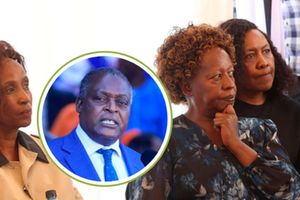Premium
Designer of Coke’s new flavour can ‘Wozzaah’ and many more

Joy Richu, the designer and illustrator behind innovative design for Coca-Cola's first-ever African-inspired drink- Wozzaah.
What you need to know:
- Richu specialises in motion and communication design and is passionate about storytelling.
- She recently became the first Kenyan selected for the Cannes Lions See It Be It programme.
The Coca-Cola Company unveiled Coca-Cola Wozzaah Zero Sugar, its latest flavour developed through its innovation platform, during a launch event held in Johannesburg.
On May 21, President William Ruto was presented with the inaugural can and a framed can artwork during his visit to the firm's headquarters in Atlanta.
Available for purchase for a limited period in select markets, including Nigeria, Algeria, South Africa, and Morocco, the flavour pays homage to the vibrancy and dynamism of the entire African continent.
During the event, the artwork of talented Kenyan designer and illustrator Joy Richu took centre stage.
Richu is the creative force behind the innovative design for Coca-Cola's first Africa-inspired beverage, "Wozzaah", derived from a Zulu term meaning "join us." This design celebrates African culture and heritage through vibrant visual storytelling.
With a design that emphasises yellow and purple with touches of teal and the brand's signature red, the Wozzaah can be distinguished from even the more avant-garde Creations range thanks to her artwork.
"From a young age, I was captivated by the power of visual storytelling. My journey into design and illustration began with hand-drawn comics, sparking a passion that drove me to pursue formal education in Digital Design at Vancouver Film School and Creative Writing at the University of British Columbia," she says, highlighting that this unique combination of skills allows her to create compelling narratives through her art, to drive positive change and fostering unity.
Richu, who specialises in motion and communication design and with a passion for storytelling through her art, has collaborated with notable brands such as Coca-Cola, The New York Times, Diageo, Mastercard, and The Dublin Inquirer.
Recently, she achieved a historic milestone as the first Kenyan selected for the Cannes Lions See It Be It programme in its 10-year history, underscoring her significant contributions to the creative industry.
"I began with limited capital, relying mainly on my design skills and passion. I invested initially in essential software and hardware for digital design and illustration. Operating independently as a freelance illustrator and designer, my business adheres to local regulations and standards within the creative industry,” she says.
Richu acknowledges that entering the competitive arena required her to highlight her distinctive style and capabilities through a robust portfolio. She says networking played a crucial role as did actively seeking opportunities for growth and collaboration across different mediums, from digital to print.
“My business distinguishes itself through narrative-driven design, celebrating cultural diversity and cultivating human connections. I seamlessly blend creativity with storytelling to craft impactful visual experiences,” she says, adding that she has collaborated with a diverse array of global clients, from large corporations to independent projects, drawing inspiration from a passion for storytelling through art.

Joy Richu, the designer and illustrator behind innovative design for Coca-Cola's first-ever African-inspired drink- Wozzaah.
However, her journey has not been without challenges. These have included the delicate balance between creative expression and meeting client expectations, navigating the complexities of the freelance landscape, and maintaining a consistent flow of projects.
“I begin my creative process with thorough research and brainstorming to grasp the brief's objectives and the target audience. Initial concepts are sketched out, allowing room for experimentation and enhancement. As I hone the direction, I shift to digital tools, integrating various techniques to achieve the desired aesthetic. I value feedback and iteration, continuously refining my work until it aligns perfectly with my vision and the client's requirements."
Richu reflects on her remarkable experience collaborating with Coca-Cola on the Wozzaah can, aimed at celebrating African culture and heritage through vibrant visual storytelling.
She credits her strong portfolio and previous work for securing the project, demonstrating her skill in bringing cultural narratives to life. Her other notable projects include designing a playing card deck for Flick Solitaire, book covers for Restless Books and Playwrights Canada Press, and editorial illustrations for The New York Times.
“My goal is to drive positive change through visual storytelling, celebrating cultural diversity and creating impactful connections between brands and audiences. Pricing is determined by project scope and complexity, with customised quotes for each client,” she says, adding that through her work, she promotes cultural understanding and pride, addressing social issues and celebrating diverse heritages with visual storytelling.
Eager to expand their creative horizons, particularly within the fashion industry, Richu aspires to collaborate with prestigious brands like Nike, envisioning her illustrations adding a distinctive style to apparel designs.
“My work naturally complements merchandise, and I am excited to explore more opportunities in this area. I am open to partnerships that foster creative expression and innovation, and I believe there's a great opportunity for my artistic vision to complement the unique identity of forward-thinking brands,” she says.
On how can design and illustration contribute to positive change and representation, particularly in African contexts, Richu says that they wield significant influence in promoting representation and effecting positive change, as they amplify diverse voices and narratives, challenge stereotypes, celebrate cultural heritage, and advocate for social justice issues through visually compelling storytelling.
“By showcasing the richness and diversity of African cultures and experiences, these mediums foster deeper understanding and empathy, empowering marginalised communities. Furthermore, design and illustration serve as potent tools for education and advocacy, raising awareness about pressing issues and inspiring action for positive change,” she adds.
Richu eagerly anticipates the upcoming collaborations to further integrate cultural storytelling into global brands.
She says that her participation in the 2024 See It Be It Cohort at the Cannes Lions Festival in France is an opportunity that will facilitate connections with industry leaders, foster creative growth, and enable her to advocate for cultural creativity worldwide.
“I envision a future where African designers and illustrators gain global recognition for their unique perspectives and contributions. I aim to create more avenues for collaboration, mentorship, and skill development, empowering emerging talents to achieve their full potential,” she concludes.





